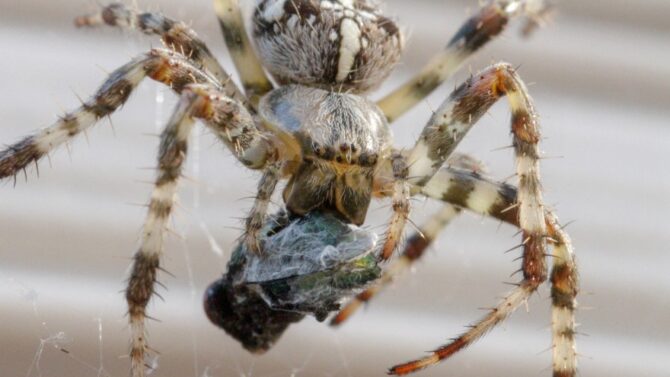Arthropods: Facts, Characteristics, Types & Pictures
Arthropods are invertebrates characterized by an exoskeleton and segmented body with paired, jointed appendages.
Being the largest phylum, the group contains over a million named species and roughly seven million terrestrial species scattered across various habitats.
Arthropod is coined from the Greek word ἄρθρονπούς (arthronpous), translated ‘joint foot.’
Therefore, the phylum’s members are identified by their jointed limbs and cuticular exoskeleton.
These facts are essential, but a few facts do not make comprehensive knowledge. We now present an explicit article that provides every crucial detail of the phylum Arthropoda.
Interesting Facts About Arthropods
- Arthropods make up eighty percent of all animal species, the largest phylum of all invertebrates, and the largest in the animal kingdom.
- Arthropods are an essential food chain member, laying at the base of most ecological systems. Remarkably, humans, the world’s apex predators, rely on arthropod species, including shrimps and lobsters, for food.
- The Japanese Spider Crab, measuring up to 12.5 feet, nearly four meters from claw to claw, is the world’s largest extant arthropod.
- While molting is a crucial stage of an arthropod’s development, it may be responsible for eighty to ninety percent of arthropod deaths due to a lack of protection and efficient mobility until the new cuticle has hardened. Therefore, molting arthropods deal with the risk of a predator attack and being trapped inside the old cuticle.
- While the phylum Arthropoda is the largest phylum in the animal kingdom, all species share a common ancestor, making them a monophyletic group.
- Arthropods generally have three body regions, but their body segments extend between less than twenty in some insects and crustaceans and over a hundred in some millipede and centipede species.
Characteristics of Arthropods
Biologists group species with similar characteristics, prompting the placement of some organisms into the phylum Arthropoda due to some unique features.
Reproduction
Most arthropods reproduce sexually. Still, a few exceptions, like barnacles, have the reproductive organs of both sexes.
It is best to conclude that some particular arthropod classes and species have reproductive traits exclusive to them or prompted due to physical or biological conditions.
The anatomy varies with aquatic arthropods as they practice a different type of fertilization.
All terrestrial arthropods practice internal fertilization, where the males insert sperm into the female reproductive tract.
However, some aquatic arthropods fertilize their eggs externally, like frogs, while others, like crustaceans, use modified mechanisms like gonopods or penises to transfer unencapsulated sperm into the female.
Remarkably, despite living on land, most species produce waterproof packets of sperm called spermatophores.
Arthropods hatch their young by laying their eggs, but some species, like scorpions, leave their eggs inside the mother’s body until it is time to hatch, producing live offspring.
Some classes hatch as small adults, some as larvae, requiring stages of metamorphosis until adulthood.
Metamorphosis
Metamorphosis in arthropods generally begins from the embryonic stage through the juvenile stage or until full development.
Metamorphosis differs slightly by species, but it is one of the phylum’s primary characteristics, manifested by behavioral adaptations and physiological transformations.
Some arthropod species like the Silverfish undergo simple or ametabolous metamorphosis, where the immature insects have parities in appearance, with most differences occurring in size.
Still, others, including species in the insect class like butterflies, beetles, and moths, undergo complete metamorphosis, where the egg hatches and grows into adulthood after completing the larva and pupa stages.
Arthropods that undergo complete metamorphosis have different forms and often exhibit contrasting behaviors at various developmental stages.
For example, the arthropod Lepidoptera under the insect class grows from its larva stage caterpillar to its adult stage butterfly but has distinctive characteristics.
Caterpillars have ocelli (simple photo-receptors consisting of a single lens and several sensory cells) that function as the eyes, while butterflies have compound eyes.
Butterflies develop wings for movement, but their larva counterparts are wingless, depending on prolegs for locomotion.
Open Circulatory System
Arthropods have an open circulatory system without containing vessels, allowing blood to flow freely through the body cavities.
Unlike annelids and vertebrates, it is impossible to differentiate between an arthropod’s blood and interstitial fluid.
A fragile, longitudinal dorsal blood vessel that runs from the abdomen through the head acts as the heart, implying that species in this phylum have no ventral heart but an artery system that delivers blood into the tissue spaces.
Segmentation
Arthropods are bilaterally symmetrical and segmented from the embryonic stage.
The three main divisions include the head, thorax, and abdomen.
Nevertheless, an arthropod’s total segments may count between less than twenty in some insects and crustaceans and over a hundred in some millipede and centipede species.
Exoskeletal Structure
As animals with exoskeletons, an arthropod’s outermost skin is made of cuticles containing pigments of chitin.
Their body segment and limb section is encapsulated in a hardened cuticle, while a flexible cuticle pads the joints between these segments and the limb sections.
Most terrestrial arthropods’ cuticles have three layers: a moisture-proof epicuticle, an exocuticle of chitin and chemically hardened proteins, and an endocuticle of chitin and unhardened proteins.
Aquatic arthropods like crustaceans have an exoskeleton made of minerals extracted from water.
This mineral-organic exoskeleton is rigid, providing protection and aiding growth.
Molting
Unlike the skin of most vertebrates, an arthropod’s cuticles are inflexible, restricting growth.
Therefore, molting, replacing the cuticle via shedding, is a distinctive characteristic generic to arthropods.
They molt with each developmental stage, following a cycle called instars.
After digesting the endocuticle, they release a molting fluid to detach the old cuticle.
Jointed Appendages
As the name “Arthropod” translates from Greek, this phylum has jointed body parts, including legs, body segments, mouthparts, and antennae.
These jointed organs aid locomotion as the muscles within the exoskeleton act together as a lever system.
Sophisticated Visual Systems
Complex vision is one of the in-depth peculiarities of arthropods, characterized by a set-up that contains simple eyes and one or both eyes being compound.
Their compound eyes comprise fifteen to thousands of independent clusters of photoreceptor cells.
Therefore, most species in this phylum have a wide field of view, fast movement detection, and, in some cases, light polarization.
Types & Classification of Arthropods
Scientists have grouped arthropods into four extant subphyla:
- Chelicerata (arachnids)
- Crustacea (crustaceans)
- Hexapods (insects and springtails)
- Myriapods (millipedes and centipedes)
- An extinct subphylum named Trilobitomorpha
The Trilobitomorpha is an extinct subphylum that roamed the earth for about 270 million years before disappearing from the planet 251 million years ago.
They were marine arthropods closely related to chelicerates (arachnids and horseshoe crabs), insects, crustaceans, and myriapods since they share a common ancestor under the clade Mandibulata.
The Trilobita was the only class under the phylum Trilobitomorpha.
Chelicerata (arachnids)
The Chelicerata is a major arthropod subdivision of which Arachnida is a dominant class.
Remarkably, the Chelicerata subphylum has been existing for over 500 million years, with several species being extinct.
However, there are about 77,000 well-identified extant chelicerate species, including horseshoe crabs, sea spiders, spiders, scorpions, and approximately 500,000 unidentified species.
The Chelicerata group has characteristics typical of arthropods, including segmented bodies and jointed appendages.
Still, marine chelicerates have some modifications that help them adapt to their habitat.
Some marine chelicerates, like the horseshoe crab, practice external fertilization, but terrestrial chelicerates, including the arachnids, fertilize internally.
While the air-breathing chelicerates have book lungs for respiration, their marine counterparts use gills for gas exchange.
The Chelicerata’s dominant class Arachnida is identified by four leg pairs, two pairs of mouthpart appendages, and two body regions (cephalothorax and abdomen).
This class holds eleven orders, including the orders Scorpiones (scorpions), Araneae (spiders), and Acari (mites).
The other extant classes include Xiphosura (horseshoe crabs) and Pycnogonida (sea spiders), while the Eurypterida (sea scorpions) is an extinct class.
Crustacea (crustaceans)
The Crustacea subphylum is a major group among the arthropods, accounting for several aquatic arthropod species, including barnacles, shrimps, and lobsters.
Crustaceans share features typical of arthropods, like the possession of an exoskeleton.
However, they are distinct from other subphylums by slight differences in their metamorphosis and possessing two-parted limbs.
While most crustaceans are aquatic, a few species, including the woodlice and sandhoppers, live on land.
Others, like Rhizocephala, fish lice, and tongue worms, live inside other organisms, while others, including barnacles, permanently attach themselves to other materials since they lack self-locomotion.
They are grouped into five taxonomic classes:
- Remipedia – a small group of twenty species of blind crustaceans
- Maxillopoda – copepods, barnacles
- Cephalocarida – class of nine identified species that live on the seafloor
- Malacostraca – amphipods, decapods, krill
- Branchiopoda – class of roughly 800 identified species
Crustaceans can grow between 0.009 inches to as long as twelve feet — the earliest crustaceans dated between 488 and 541 million years ago during the Cambrian period.
However, the sub-phylum currently accommodates over 40,000 identified extant species.
Hexapods (insects and springtails)
The name Hexapoda is coined from two Greek words, “hexa,” meaning six, and “poda,” meaning legs.
Therefore, hexapods are six-legged subphylums of the phylum Arthropoda, where the classes Insecta and Entognatha belong.
Three body regions (head, abdomen, and thorax), each with a pair of legs and six closely fused segments, characterize hexapods.
Scientists have identified over one million insect species insects that form most of the hexapod subphylum.
Hexapods’ earliest earth records date to over 400 million years ago.
Myriapods (millipedes and centipedes)
About 13,000 terrestrial species, characterized by their many legs, belong to this arthropod subphylum.
Remarkably, myriapod is derived from two words, “muríos,” meaning ten thousand, and “poús,” meaning foot.
Millipedes under the class Diplopoda, centipedes under the Chilopoda, and two other classes, Symphyla and Pauropoda, are grouped under myriapods.
Frequently Asked Questions
What are an arthropod’s most prominent characteristics?
A specie must possess an exoskeleton, jointed appendages, a segmented, bilaterally symmetrical body, and an open circulatory system.
Which animals fall under the phylum Arthropoda?
Arachnids like spiders and scorpions, insects like butterflies and moths, crustaceans like crabs and lobsters, and millipedes and centipedes are animal species under the phylum Arthropoda.
When did the first arthropods evolve?
Fossil records reveal that the first arthropods evolved between 541 to 485.4 million years ago, represented by the extinct subphylum Trilobitomorpha.
How did the arthropods adapt to land?
While the earliest species of the phylum Arthropoda were aquatic, they started developing modifications, including reduced body size, antenna or compound eyes for sight, and tracheae or book lungs for breathing.
What is the life cycle of an amphibian?
Arthropods undergo developmental stages in their life cycle, developing from embryonic eggs to adults via ametabolous or complete metamorphosis.
Wrap Up
Scientists estimate the total number of extant arthropods to be over 30 million, accounting for about eighty percent of all animal species.
We are thrilled by the phylum’s diversity and intrigued by the evolution of surviving species.
Therefore, we should endeavor to support all conservation efforts, ensuring the continuity of all extant species in the phylum Arthropoda and the animal kingdom on a larger scale.





